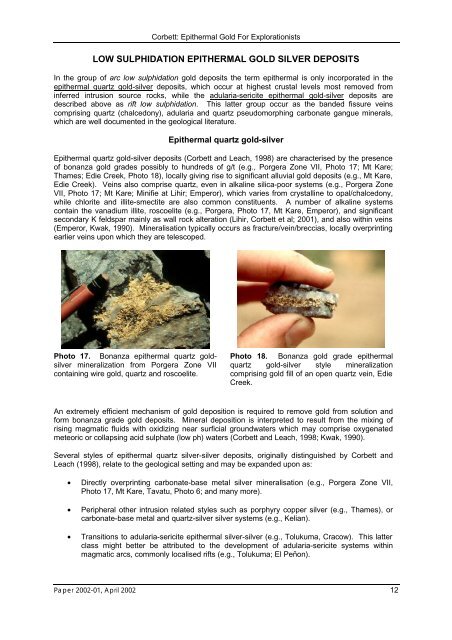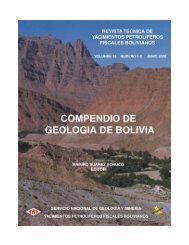Exploraciones por oro epitermal
Create successful ePaper yourself
Turn your PDF publications into a flip-book with our unique Google optimized e-Paper software.
Corbett: Epithermal Gold For Explorationists<br />
LOW SULPHIDATION EPITHERMAL GOLD SILVER DEPOSITS<br />
In the group of arc low sulphidation gold deposits the term epithermal is only incor<strong>por</strong>ated in the<br />
epithermal quartz gold-silver deposits, which occur at highest crustal levels most removed from<br />
inferred intrusion source rocks, while the adularia-sericite epithermal gold-silver deposits are<br />
described above as rift low sulphidation. This latter group occur as the banded fissure veins<br />
comprising quartz (chalcedony), adularia and quartz pseudomorphing carbonate gangue minerals,<br />
which are well documented in the geological literature.<br />
Epithermal quartz gold-silver<br />
Epithermal quartz gold-silver deposits (Corbett and Leach, 1998) are characterised by the presence<br />
of bonanza gold grades possibly to hundreds of g/t (e.g., Porgera Zone VII, Photo 17; Mt Kare;<br />
Thames; Edie Creek, Photo 18), locally giving rise to significant alluvial gold deposits (e.g., Mt Kare,<br />
Edie Creek). Veins also comprise quartz, even in alkaline silica-poor systems (e.g., Porgera Zone<br />
VII, Photo 17; Mt Kare; Minifie at Lihir; Emperor), which varies from crystalline to opal/chalcedony,<br />
while chlorite and illite-smectite are also common constituents. A number of alkaline systems<br />
contain the vanadium illite, roscoelite (e.g., Porgera, Photo 17, Mt Kare, Emperor), and significant<br />
secondary K feldspar mainly as wall rock alteration (Lihir, Corbett et al; 2001), and also within veins<br />
(Emperor, Kwak, 1990). Mineralisation typically occurs as fracture/vein/breccias, locally overprinting<br />
earlier veins upon which they are telescoped.<br />
Photo 17. Bonanza epithermal quartz goldsilver<br />
mineralization from Porgera Zone VII<br />
containing wire gold, quartz and roscoelite.<br />
Photo 18. Bonanza gold grade epithermal<br />
quartz gold-silver style mineralization<br />
comprising gold fill of an open quartz vein, Edie<br />
Creek.<br />
An extremely efficient mechanism of gold deposition is required to remove gold from solution and<br />
form bonanza grade gold deposits. Mineral deposition is interpreted to result from the mixing of<br />
rising magmatic fluids with oxidizing near surficial groundwaters which may comprise oxygenated<br />
meteoric or collapsing acid sulphate (low ph) waters (Corbett and Leach, 1998; Kwak, 1990).<br />
Several styles of epithermal quartz silver-silver deposits, originally distinguished by Corbett and<br />
Leach (1998), relate to the geological setting and may be expanded upon as:<br />
• Directly overprinting carbonate-base metal silver mineralisation (e.g., Porgera Zone VII,<br />
Photo 17, Mt Kare, Tavatu, Photo 6; and many more).<br />
• Peripheral other intrusion related styles such as <strong>por</strong>phyry copper silver (e.g., Thames), or<br />
carbonate-base metal and quartz-silver silver systems (e.g., Kelian).<br />
• Transitions to adularia-sericite epithermal silver-silver (e.g., Tolukuma, Cracow). This latter<br />
class might better be attributed to the development of adularia-sericite systems within<br />
magmatic arcs, commonly localised rifts (e.g., Tolukuma; El Peñon).<br />
Paper 2002-01, April 2002 12
















